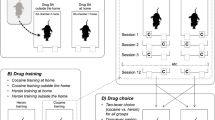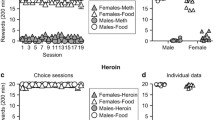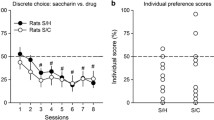Abstract
Rationale
Heroin users report reward deficits as well as reward enhancements (to drug stimuli). To better understand the causal relation between chronic heroin and alterations in natural reward processing, we used experimental techniques in animal models.
Methods
Separate groups of rats were trained in several food reward paradigms: conditioned place preference (CPP), food-reinforced lever pressing under a progressive ratio schedule of reinforcement, free feeding, and lever pressing with conditioned reinforcement. After training, the rats were subjected to 10 daily heroin (2 mg/kg) or saline vehicle injections and tested at 3, 15, and 30 days post-treatment.
Results
Repeated heroin treatment abolished the CPP and significantly reduced break points for food reward at 3, 15, and 30 days post-treatment. Repeated heroin did not affect free feeding. Finally, repeated heroin significantly enhanced responding for a food-based conditioned reinforcer.
Conclusions
Repeated heroin decreases the attractiveness of food-associated cues and reduces motivation to work for natural reward. However, it appears to enhance natural conditioned reward processes that involve the acquisition of novel responding. Thus, repeated heroin appears to produce differential effects on natural reward processing depending on the nature of the reward-directed behavior.





Similar content being viewed by others
References
Babbini M, Gaiardi M, Bartoletti M (1976) Changes in fixed-interval behavior during chronic morphine treatment and morphine abstinence in rats. Psychopharmacologia 45:255–259
Beninger RJ, Miller R (1998) Dopamine D1-like receptors and reward-related incentive learning. Neurosci Biobehav Rev 22:335–345
Berridge KC, Robinson TE (1998) What is the role of dopamine in reward: hedonic impact, reward learning, or incentive salience? Brain Res Rev 28:309–369
Carlezon WA Jr, Nestler EJ (2002) Elevated levels of GluR1 in the midbrain: a trigger for sensitization to drugs of abuse? Trends Neurosci 25:610–615
Cobuzzi JL, Riley AL (2011) Spontaneous withdrawal in opiate-dependent Fischer 344, Lewis and Sprague–Dawley rats. Pharmacol Biochem Behav 98:28–34
Cooper ZD, Shi YG, Woods JH (2010) Reinforcer-dependent enhancement of operant responding in opioid-withdrawn rats. Psychopharmacol (Berl) 212:369–378
Ford RD, Balster RL (1976) Schedule-controlled behavior in the morphine-dependent rat. Pharmacol Biochem Behav 4:569–573
Harris GC, Aston-Jones G (2003) Altered motivation and learning following opiate withdrawal: evidence for prolonged dysregulation of reward processing. Neuropsychopharmacology 28:865–871
Harris GC, Aston-Jones G (2007) Activation in extended amygdala corresponds to altered hedonic processing during protracted morphine withdrawal. Behav Brain Res 176:251–258
Harty SC, Whaley JE, Halperin JM, Ranaldi R (2011) Impulsive choice, as measured in a delay discounting paradigm, remains stable after chronic heroin administration. Pharmacol Biochem Behav 98:337–340
Jaffe JH (1990) Drug addiction and drug abuse. In: Gilman AG, Rall TW, Nies AS, Taylor P (eds) Goodman and Gilman’s the pharmacological basis of therapeutics. Pergamon Press, New York, pp 522–573
Kenny PJ, Chen SA, Kitamura O, Markou A, Koob GF (2006) Conditioned withdrawal drives heroin consumption and decreases reward sensitivity. J Neurosci 26:5894–5900
Koob GF (1996) Drug addiction: the yin and yang of hedonic homeostasis. Neuron 16:893–896
Lieblich I, Yirmiya R, Liebeskind JC (1991) Intake of and preference for sweet solutions are attenuated in morphine-withdrawn rats. Behav Neurosci 105:965–970
Liu J, Schulteis G (2004) Brain reward deficits accompany naloxone-precipitated withdrawal from acute opioid dependence. Pharmacol Biochem Behav 79:101–108
Lubman DI, Yucel M, Kettle JW, Scaffidi A, Mackenzie T, Simmons JG, Allen NB (2009) Responsiveness to drug cues and natural rewards in opiate addiction: associations with later heroin use. ArchGenPsychiatry 66:205–212
Martin-Soelch C, Chevalley AF, Kunig G, Missimer J, Magyar S, Mino A, Schultz W, Leenders KL (2001) Changes in reward-induced brain activation in opiate addicts. Eur J Neurosci 14:1360–1368
Morrison J, Thornton V, Ranaldi R (2011) Chronic intermittent heroin produces locomotor sensitization and long-lasting enhancement of conditioned reinforcement. Pharmacol Biochem Behav 99:475–479
Nocjar C, Panksepp J (2007) Prior morphine experience induces long-term increases in social interest and in appetitive behavior for natural reward. Behav Brain Res 181:191–199
Parker L, Failor A, Weidman K (1973) Conditioned preferences in the rat with an unnatural need state: morphine withdrawal. J Comp Physiol Psychol 82:294–300
Ranaldi R, Egan J, Kest K, Fein M, Delamater AR (2009) Repeated heroin in rats produces locomotor sensitization and enhances appetitive Pavlovian and instrumental learning involving food reward. Pharmacol Biochem Behav 91:351–357
Rasmussen K, Beitner-Johnson DB, Krystal JH, Aghajanian GK, Nestler EJ (1990) Opiate withdrawal and the rat locus coeruleus: behavioral, electrophysiological, and biochemical correlates. J Neurosci 10:2308–2317
Rescorla RA, Solomon RL (1967) Two-process learning theory: relationships between Pavlovian conditioning and instrumental learning. Psychol Rev 74:151–182
Russell MAH (1976) What is dependence? In: Edwards G (ed) Drugs and drug dependence. Lexington Books, Lexington, pp 182–187
Sell LA, Morris J, Bearn J, Frackowiak RS, Friston KJ, Dolan RJ (1999) Activation of reward circuitry in human opiate addicts. Eur J Neurosci 11:1042–1048
Spanagel R, Shippenberg TS (1993) Modulation of morphine-induced sensitization by endogenous kappa opioid systems in the rat. Neurosci Lett 153:232–236
Tjon GH, De Vries TJ, Nestby P, Wardeh G, Mulder AH, Schoffelmeer AN (1995) Intermittent and chronic morphine treatment induces long-lasting changes in delta-opioid receptor-regulated acetylcholine release in rat striatum and nucleus accumbens. Eur J Pharmacol 283:169–176
Vanderschuren LJ, Tjon GH, Nestby P, Mulder AH, Schoffelmeer AN, De Vries TJ (1997) Morphine-induced long-term sensitization to the locomotor effects of morphine and amphetamine depends on the temporal pattern of the pretreatment regimen. Psychopharmacol (Berl) 131:115–122
Wise RA (1996) Addictive drugs and brain stimulation reward. Annu Rev Neurosci 19:319–340
Wise RA (2004) Dopamine, learning and motivation. Nat Rev Neurosci 5:483–494
Wise RA, Rompre PP (1989) Brain dopamine and reward. Annu Rev Psychol 40:191–225
Zellner MR, Ranaldi R (2010) How conditioned stimuli acquire the ability to activate VTA dopamine cells: a proposed neurobiological component of reward-related learning. Neurosci Biobehav Rev 34:769–780
Zhang D, Zhou X, Wang X, Xiang X, Chen H, Hao W (2007) Morphine withdrawal decreases responding reinforced by sucrose self-administration in progressive ratio. Addict Biol 12:152–157
Zijlstra F, Veltman DJ, Booij J, van den Brink W, Franken IH (2009) Neurobiological substrates of cue-elicited craving and anhedonia in recently abstinent opioid-dependent males. Drug Alcohol Depend 99:183–192
Conflict of interest
There are no conflicts of interest with this work.
Author information
Authors and Affiliations
Corresponding author
Rights and permissions
About this article
Cite this article
Galaj, E., Cruz, I., Schachar, J. et al. Differential effects on natural reward processing in rats after repeated heroin. Psychopharmacology 229, 125–132 (2013). https://doi.org/10.1007/s00213-013-3087-8
Received:
Accepted:
Published:
Issue Date:
DOI: https://doi.org/10.1007/s00213-013-3087-8




